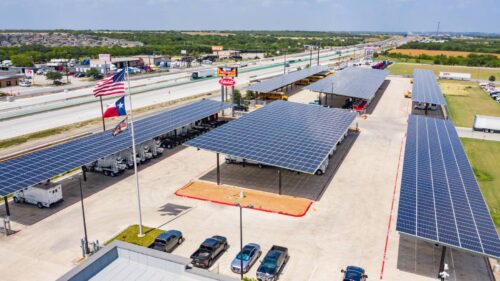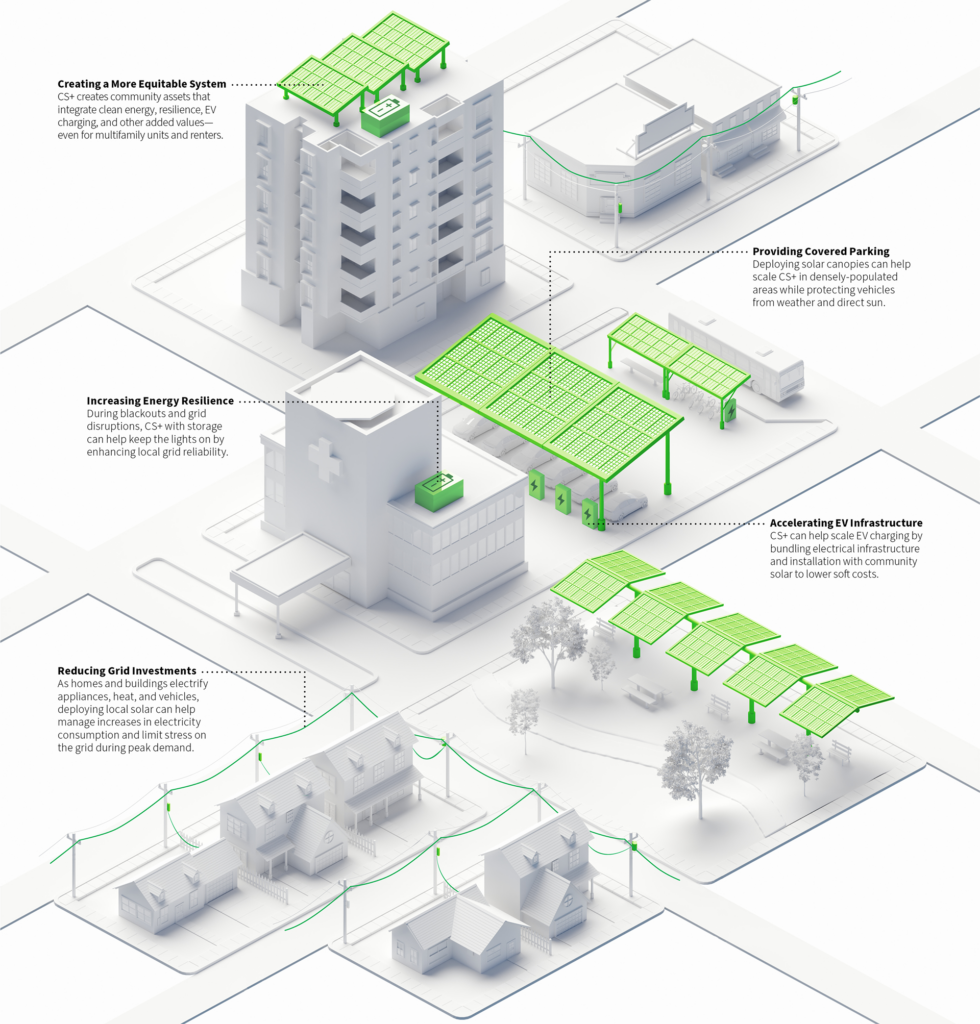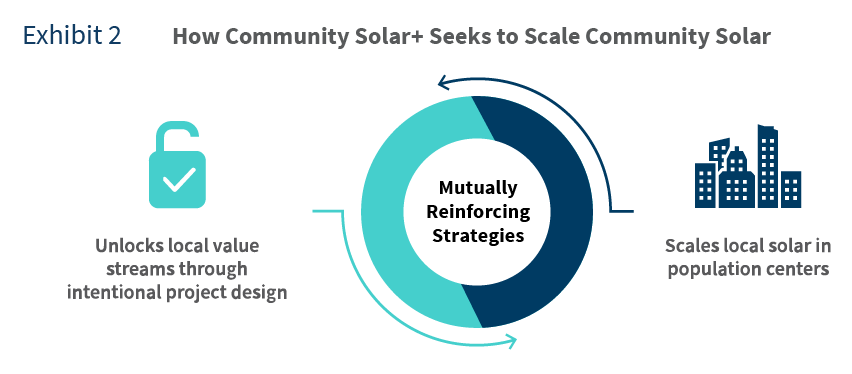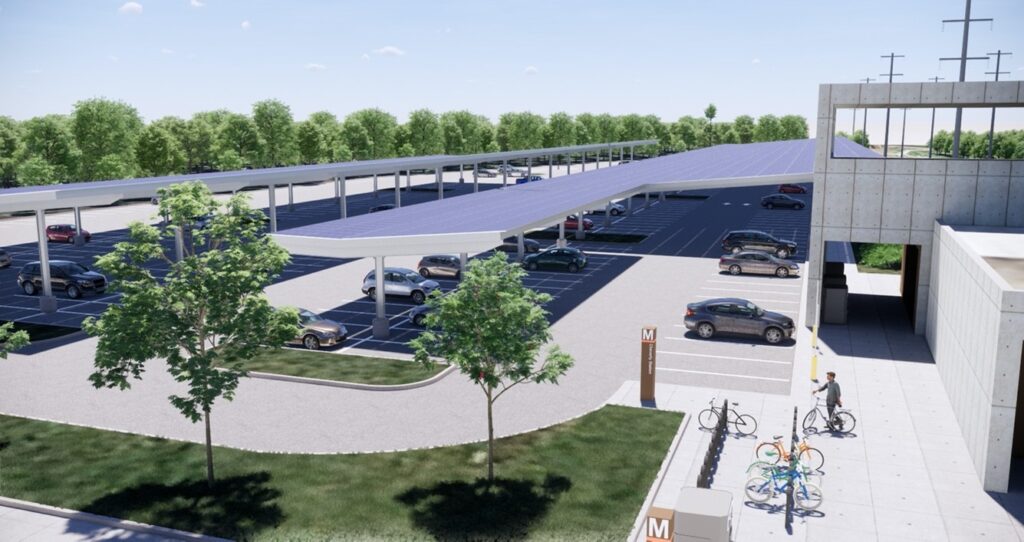
Introducing Community Solar+: the Next Generation of Community Solar
The first generation of community solar has truly enabled greater access to solar energy across the United States. Through innovative subscription programs and policies, community solar offers opportunities for many residential customers — including renters, people living in multifamily residential buildings, and those without a viable rooftop for hosting solar — to buy clean energy and reduce their energy burden. And momentum is building for community solar, with new and expanded programs from New Mexico to New York to Washington.
But community solar has the potential to do far more. Further innovation, creativity, and holistic planning can allow states and local governments to leverage community solar to meet their ambitious climate action targets more strategically and equitably. In our new report Community Solar+: How the Next Generation of Community Solar Can Unlock New Value Streams and Help Communities Pursue Holistic Decarbonization, RMI introduces our vision for Community Solar+ (CS+): community solar projects that are deliberately planned and strategically deployed to embrace added value streams and advance community-wide sustainability and equity goals.
Welcome to the world of Community Solar+.
Sometimes a problem can’t be solved not because it’s too big, but because it was framed so narrowly that its boundaries don’t encompass the options, degrees of freedom, and synergies needed to solve it. CS+ aims to fix that by expanding the boundaries.
Providing a Whole-Systems Approach to Community-Wide Sustainability
In addition to clean energy access, community solar projects have the potential to provide even more benefits to communities. Our report highlights six value streams that, when designed and deployed in tandem with a community solar project, make it a CS+ project:
- Accelerating investment in EV charging infrastructure
- Increasing energy resilience for critical assets and vulnerable communities
- Aligning evolving grid and customer needs for an electrified future
- Creating a more equitable energy system
- Providing covered parking and weather protection
- Mitigating the urban heat island effect

The innovation here is two-fold: 1) CS+ can strategically unlock added value to advance community-wide climate and equity goals, and 2) CS+ aims to scale local solar in population centers. These elements reinforce each other directly.

By creating and capturing additional value, CS+ project managers can more strategically finance and develop projects in population centers, where land is most scarce and electricity demand is typically greatest. Similarly, by scaling in population centers, projects may be able to further create and capture additional value and economic efficiencies that smaller urban projects may not have been able to achieve.
Community Solar+ in Action
This approach is not just theoretical. Our report highlights four examples across three cities embracing CS+ approaches: Denver, San Antonio, and Washington, D.C.
In December 2021, Denver’s City Council approved funding for Phase 1 of the Renewable Denver Initiative — an estimated 4.6 MW of community solar deployed across municipal rooftops, parking lots, and vacant land. The solar will be shared between the city and residents — with at least 20 percent of the energy generated by the solar arrays allocated to income-qualified housing and low-income residents to help alleviate their energy burden.
This project goes even further to create community assets, though. Solar parking canopies will offer publicly accessible, free EV charging and covered parking. Communities will also have direct access to workforce training and education coordinated with schools where projects are sited. In these ways, Denver is enhancing the overall project value to the community with scale in mind — the next project phase is expected to reach a combined total of 15 MW.
This initiative is an opportunity to improve our air, mitigate the effects of climate change, and invest in our community… and by leading on climate issues, it’s also a way to help residents lower their electric bills… [and] co-locate with publicly accessible electric vehicle charging stations.
In 2019, the Pepco Resiliency Center in Washington, D.C., deployed 62.4 kW of community solar paired with storage, microgrid, and generator capabilities. This offers cost savings, clean energy, and energy resilience for this multifamily, affordable housing complex. Housing developer Jubilee Housing worked with the City’s Solar for All initiative to bring clean energy to the community and stressed the added value of having backup power in a region that faces power outages due to hurricanes, snow and ice, and other events. The project provides up to three days of backup power to critical loads, including lights in stairs and hallways, a refrigerator for food and medicine, several outlets for medical equipment and cell phone charging, a water pump, and floor fans. Moreover, this creates a fundamentally more equitable energy system by reducing resident energy burdens.
Resiliency is especially important for vulnerable communities that already experience great uncertainty in the course of their lives.
Lastly, two other projects highlight added values from hosting CS+ projects on public and private parking facilities. In 2020, both Washington, D.C.’s transit agency and San Antonio’s municipal utility contracted for community solar projects to help enable utility-scale community solar projects. The Washington Metropolitan Area Transit Authority (WMATA) announced that it would partner with SunPower Corporation and Goldman Sachs Renewable Power LLC to install 12.8 MW of solar canopies on its parking lots and garages. Leasing space for solar energy generation on WMATA-owned facilities offered the transit agency the opportunity to capture approximately $50 million in new revenue through 2047 to support WMATA’s transit operations while providing covered parking to hundreds more transit riders daily. An estimated 1,500 D.C. and Maryland households served by the utility Pepco will soon be able to subscribe to the electricity generated by this project.

Similarly, CPS Energy, San Antonio’s municipal utility, contracted with Big Sun Solar to developed 5 MW of community solar across 12 locations. Through the program, 500 to 600 of the utility’s residential customers will buy panels from Big Sun Solar and receive a fixed-rate production credit on their electricity bill. The Big Sun Community Solar project integrated added value by designing systems to be ready for EV charging and capturing new revenue from covered parking on private parking facilities.
In my community, traditional community solar models are still out of reach for most households because of the costs. With Big Sun Solar, we expanded the value stack of the generation assets. In central Texas, covered parking makes sense because people value shade. The additional capital to build the carports is offset by revenue for covered and reserved parking.
How States, Municipalities, and Utilities Can Embrace Community Solar+
The US Department of Energy set a goal of powering 5 million homes with community solar by 2025, an increase of more than 700 percent in the next four years. Our report offers numerous recommendations and resources to help states, local governments, and utilities turn these community solar projects into CS+ projects.
- In addition to setting market conditions that will enable and accelerate community solar, state leaders can also create programs that explicitly incentivize added value streams and ensure limited-income residents can participate and access the benefits, such as Massachusetts’ SMART program.
- Local leaders can plan effectively and structure projects to enable flexibility in design. This could include streamlining permitting for solar projects, publicizing market opportunities to spur local innovation, reassessing the value that they can leverage from both public and private parking facilities, and acting as an anchor off-taker or guarantor of subscriptions for community solar projects to help increase the scale and reduce risks for a project developer.
- Utilities can further support their customers and set projects up for success by integrating CS+ into their business models, publicizing market opportunities to spur local innovation, and designing systems to simplify eligibility, payment, and subscription changes.
Ultimately, our challenge to both the public and private sector here is to expand the boundaries of solar projects. Think about your broader goals such as electrifying your vehicle fleet, expanding local resilience, and mitigating heat. Or think creatively about your local “assets” and what types of sites you can leverage that might benefit from creative uses of solar.
Given the challenges of realizing a just energy transition within the confines of a climate crisis, CS+ provides additional value streams that benefit both the community and the grid — encouraging a more electrified, resilient, and equitable future.
The next generation of community solar is here. It’s time to embrace Community Solar+.
For more information on community solar, check out the full Community Solar+ report here and our resource portal CityRenewables.org.
